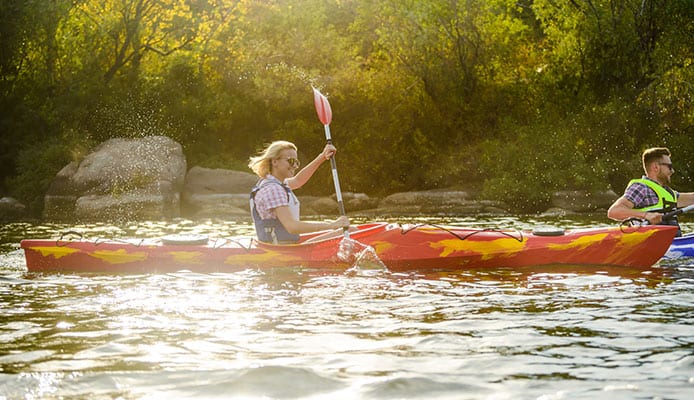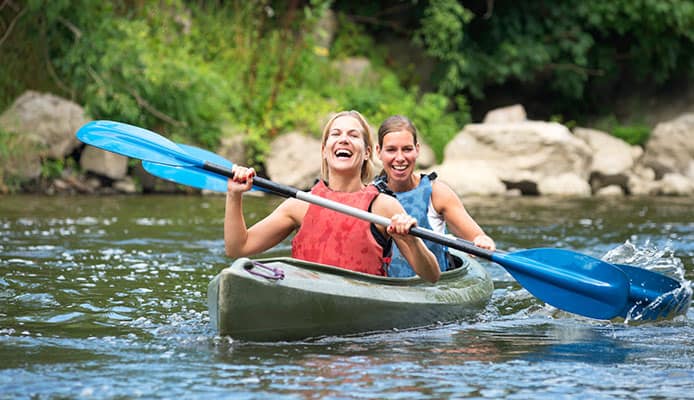
If you are a serious kayaker, then you know that not every day is a good day. There are times when the water is flat and fun to slice. Other times it’s all rough and turbulent and you need to fight really hard to prevent the kayak from flipping and losing your kayak paddle.
That is when advanced skills like edging and bracing come to play. You need to maintain a good balance and control of your watercraft so you can be able to right it in case of a capsize.
But you must hone basic kayak self-rescue skills first. These include things like getting back in a kayak after it’s flipped over and doing a wet exit and re-entry. Only then you will be able to advance to more complex maneuvers like kayak edging and bracing.
What Is Kayak Edging?
This is when you slant your kayak a little bit to one side to find a firm balancing point that allows you to do things like turning faster or making more precise turns. The idea is to maintain good paddling posture by keeping your body weight at the center of the watercraft while at the same time adjusting the gradient of the tilt.
How To Edge Your Kayak
Here is the simplest way to do a kayak edge. We suggest that you take some time to learn the steps before starting your kayak adventure. So grab your life jacket and a floating device and let’s get the show on the road!
- With your kayak in a stationary position, raise the shaft of your paddle toward your shoulders while turning your wrists backward.
- Release the grip such that the shaft now rests on the bottom of your thumbs.
- Using your lower body, start controlling the kayak. Slowly raise your right knee to lift the right side of your vessel.
- Make sure that you are only tilting the kayak, not the upper part of your body. Your torso needs to stay as upright as possible and near the center of the kayak so that its weight remains distributed at this point. Leaning your body risks flipping the boat.
- Return the kayak to its original position by slowly lifting your left knee.
- Repeat this process with your left knee. Keep practicing until you can comfortably balance and hold your watercraft on each tilt, using only the lower part of your body to control it.
- Once you start feeling confident in your kayak edging, you can add the paddle and attempt a sweep turn on each side of your watercraft.
You will feel more comfortable and make more precise and sharp turns when you go for your kayaking trip than if you had not taken the time to learn and practice.
You might also like: How To Paddle A Tandem Kayak?
Kayak Brace Stroke
If you just started to learn how to kayak, another important trick you need to get familiar with is kayak bracing. A kayak brace stroke is usually an emergency stunt meant to reverse an edge that is heading to a capsize.
How To Do Kayak Bracing
Low Brace
A low brace is performed when a kayaker slightly loses his balance. If you are almost falling over, this stunt can help you go back up without even getting soaked. The word “low” means that the paddle will remain under your elbows throughout the stunt. To do a low kayak brace:
- Get to the right posture. Place the paddle near your hip and make sure that the back face of the blade is pointing toward the side you wish to lean. Then grip your paddle.
- Tilt your boat to the right until you start to fall over. Once you have lost your body balance slightly, push the blade against the water surface quickly, and move your body weight on the paddle. Ensure that your paddle stays in a horizontal position so you can get the best support.
- Get the kayak back to the right position by twisting your hip and pushing the deck with the left knee. Don’t worry about your torso. Tilt your watercraft back to position first and then push your torso back to balance.
- With your kayak back up, its rotating force will help you move your upper body to its original posture. Repeat this process with a left tilt and keep alternating until you are completely comfortable with the stunt. If a low brace doesn’t work for you, try switching to high bracing.
High Brace
A high kayak brace stroke is performed when the kayaker loses his balance completely and doesn’t have enough time to do a low brace. The technique you are going to use here will depend on how inclined you are and what position you can start in. The shaft of your paddle will start higher than in a low brace. To get started:
- Tilt to the right until you begin to fall. Make sure your paddle remains above the water. Keep your shoulders and hands close to your body.
- Once the upper part of your body is half-submerged, use your hips and knees to get the kayak back up, while pulling your paddle against the water.
- After the vessel is back up, quickly pull your torso upright but keep pressing your paddle down.
Keep practicing until you have mastered all these stunts properly on both sides. You can even try switching between a canoe, a sit inside, and a sit on top kayak to make your skills even better.
Globo Surf Overview
Flipping a kayak is every kayaker’s nightmare. It can turn a fun-filled trip into a disaster. The most effective way to avoid finding yourself in a sticky kayak capsize situation is learning basic self-rescue techniques and a kayak edging and bracing could be a great place to get started. Just don’t forget to pack up your kayak safety kit in case things get completely messy.
More Skils Guides:
- Plastic Kayak Repair Guide
- How To Properly Strap Two Kayaks Into A Car Roof Rack
- How To Roll A Kayak
- How And Where To Sit In A Kayak
- What Muscles Are Used In Kayaking
- How To Easily Tow A Kayak
- What Is A Kayak Wet Exit And Entry And How To Properly Do It?
- How to Carry a Kayak: The Right Way!
- How to Get In and Out of a Kayak


